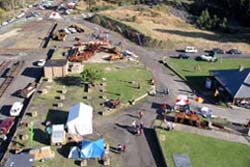 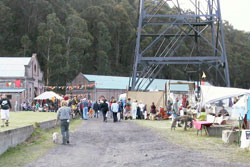
Photos: Ian Rufus (left) and Len Ashworth (right)
State Mine Heritage Park & Railway – Project is NSW’s Biggest
“Lithgow was well on the way to having the biggest cultural heritage complex in New South Wales”, Kevin Moss, Parliamentary Secretary to the Ministry of Transport said at the weekend. Mr Moss was performing the official opening of the State Mine Heritage Park Mine Museum & Railway. The opening coincided with the annual Ironfest carnival that was held at the Mine Museum for the first time. Mr Moss was representing Premier Carr and Transport Minister Scully at the ceremony.
He was accompanied by official guests including Member for Bathurst Gerard Martin, Mayor Neville Castle, Mayor of Blue Mountains Jim Angel, chairman of the Mine Museum committee Ray Christison, and Spencer Ross, representing the Australian Railway Historical Society. Introducing the guests, Mr Martin said it had taken many years of trials and tribulations to reach the present stage of development of the museum on the site of the old State Mine.
He said not the least of the obstacles to be overcome was the disastrous fire of October last year that destroyed so much of the museum's valuable collection of rare railway rolling stock.
"It is a great testament to all concerned that they did not drop their bundle after the fire and are now working with renewed determination," he said.
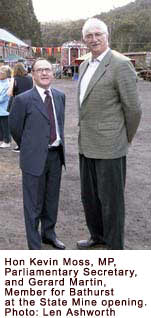 Mr Martin referred to the importance of the project to the region's industrial heritage. He said that over the years Lithgow had not had a good record in rectifying the scars of pioneering industry. It had only been in comparatively recent times that the city had begun cleaning up what the early entrepreneurs had left behind and “getting rid of an unwanted legacy'” Mr Martin referred to the importance of the project to the region's industrial heritage. He said that over the years Lithgow had not had a good record in rectifying the scars of pioneering industry. It had only been in comparatively recent times that the city had begun cleaning up what the early entrepreneurs had left behind and “getting rid of an unwanted legacy'”
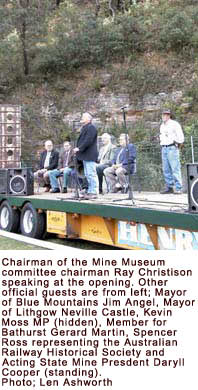 Mr Martin said the State Mine Museum was a unique example of what could be achieved in recycling an old industrial site to make an invaluable contribution to the new Lithgow. He said it was obvious the museum had provided Mr Martin said the State Mine Museum was a unique example of what could be achieved in recycling an old industrial site to make an invaluable contribution to the new Lithgow. He said it was obvious the museum had provided
an ideal site to host Ironfest. Mr Moss said that at least 10 NSW Government agencies including State Rail, the Department of Mineral Resources, the Ministry for the Arts and the State Heritage Office had been involved in supporting the State Mine Heritage Park development.
But he also paid tribute to the support of the Federal Government with its Centenary of Federation funding which had provided an enormous boost. Lithgow Council and various corporate bodies had also done their bit but nothing would have happened without the efforts of the volunteer workers.
"This place has ‘volunteer support' written all over it," he said. Mr Moss said the project was unique in the number of industrial heritage components that would be linked together with a tourist railway over the rehabilitated industrial railway sidings - the State Mine, Lake Pillans, Blast Furnace Park, Eskbank House, and Eskbank Loco Yards.
This, he said, already made it one of the biggest cultural heritage projects in NSW.
"When it is also linked with the Zig Zag Railway, as planned, it will be the State's biggest heritage precinct," Mr Moss said. This would be enhanced by the current development of a co-ordination plan to market all of the area's heritage attractions, embracing such places as the SAF Museum and the. Old Lithgow Pottery.
"It. is the first time a single plan has been developed for an entire town," Mr Moss said.
"I believe Lithgow epitomises the industrial pioneering town that is truly worthy of preservation. Places like Port Kembla and Newcastle may argue they are more worthy but they had convenient sea access while Lithgow's industrialists had to contend with the Blue Mountains, as they still do today."
The move to the Mine Museum was a good one fox. the Ironfest organisers who experienced probably their best result since the annual 'Crucible of Fire' concept was launched. Exhibitors came from as far away 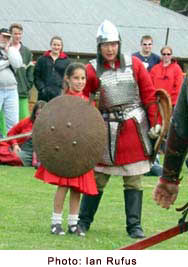 as Victoria to exhibit their artworks and creations in metal, ranging from the bizarre to the functional. But there was no denying the levels of talent on display. Many of the exhibitors attracted plenty of attention as they paraded in mediaeval outfits. as Victoria to exhibit their artworks and creations in metal, ranging from the bizarre to the functional. But there was no denying the levels of talent on display. Many of the exhibitors attracted plenty of attention as they paraded in mediaeval outfits.
More conventional artists also displayed their wares with paintings and sculpture. There was an international flavour added to the occasion by food stalls from various nations.
Live music and other entertainments increased the appeal of the week- end. Museum officials estimated that around 2000 paying customers visited the site over the two days, including one from Western Australia.
A spokesman said “there were as many out of town tourists as locals”. He said the numbers in the museum grounds were increased considerably when the exhibitors were taken into account. All concerned appeared well pleased with the outcome of the weekend.
Story: LEN ASHWORTH, Lithgow Mercury, Tuesday 30 April 2002.
|

